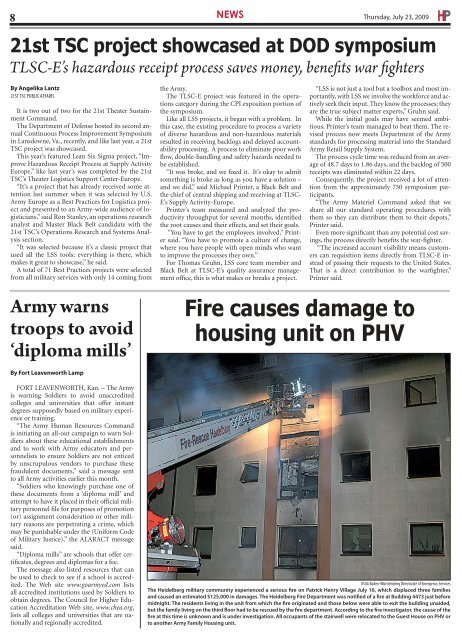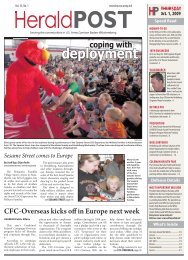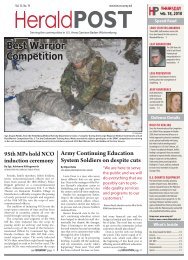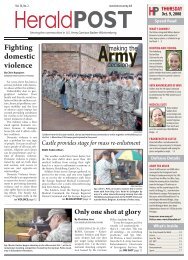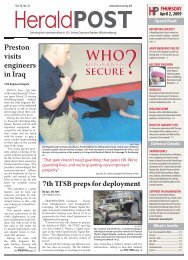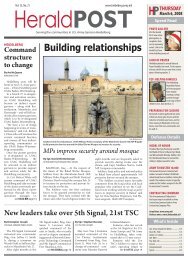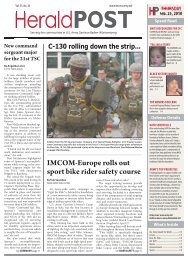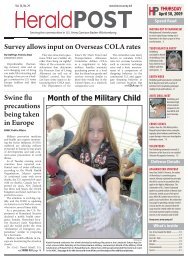Herald Post 2009-07-23.pdf
Herald Post 2009-07-23.pdf
Herald Post 2009-07-23.pdf
You also want an ePaper? Increase the reach of your titles
YUMPU automatically turns print PDFs into web optimized ePapers that Google loves.
8 NEWS<br />
Thursday, July 23, <strong>2009</strong> HP<br />
21st TSC project showcased at DOD symposium<br />
TLSC-E’s hazardous receipt process saves money, benefits war fighters<br />
By Angelika Lantz<br />
21ST TSC PUBLIC AFFAIRS<br />
It is two out of two for the 21st Theater Sustainment<br />
Command.<br />
The Department of Defense hosted its second annual<br />
Continuous Process Improvement Symposium<br />
in Lansdowne, Va., recently, and like last year, a 21st<br />
TSC project was showcased.<br />
This year’s featured Lean Six Sigma project, “Improve<br />
Hazardous Receipt Process at Supply Activity<br />
Europe,” like last year’s was completed by the 21st<br />
TSC’s Theater Logistics Support Center-Europe.<br />
“It’s a project that has already received some attention<br />
last summer when it was selected by U.S.<br />
Army Europe as a Best Practices for Logistics project<br />
and presented to an Army-wide audience of logisticians,”<br />
said Ron Stanley, an operations research<br />
analyst and Master Black Belt candidate with the<br />
21st TSC’s Operations Research and Systems Analysis<br />
section.<br />
“It was selected because it’s a classic project that<br />
used all the LSS tools; everything is there, which<br />
makes it great to showcase,” he said.<br />
A total of 71 Best Practices projects were selected<br />
from all military services with only 14 coming from<br />
the Army.<br />
The TLSC-E project was featured in the operations<br />
category during the CPI exposition portion of<br />
the symposium.<br />
Like all LSS projects, it began with a problem. In<br />
this case, the existing procedure to process a variety<br />
of diverse hazardous and non-hazardous materials<br />
resulted in receiving backlogs and delayed accountability<br />
processing. A process to eliminate poor work<br />
flow, double-handling and safety hazards needed to<br />
be established.<br />
“It was broke, and we fixed it. It’s okay to admit<br />
something is broke as long as you have a solution –<br />
and we did,” said Michael Printer, a Black Belt and<br />
the chief of central shipping and receiving at TLSC-<br />
E’s Supply Activity-Europe.<br />
Printer’s team measured and analyzed the productivity<br />
throughput for several months, identified<br />
the root causes and their effects, and set their goals.<br />
“You have to get the employees involved,” Printer<br />
said. “You have to promote a culture of change,<br />
where you have people with open minds who want<br />
to improve the processes they own.”<br />
For Thomas Gruhn, LSS core team member and<br />
Black Belt at TLSC-E’s quality assurance management<br />
office, this is what makes or breaks a project.<br />
“LSS is not just a tool but a toolbox and most importantly,<br />
with LSS we involve the workforce and actively<br />
seek their input. They know the processes; they<br />
are the true subject matter experts,” Gruhn said.<br />
While the initial goals may have seemed ambitious,<br />
Printer’s team managed to beat them. The revised<br />
process now meets Department of the Army<br />
standards for processing material into the Standard<br />
Army Retail Supply System.<br />
The process cycle time was reduced from an average<br />
of 48.7 days to 1.86 days, and the backlog of 500<br />
receipts was eliminated within 22 days.<br />
Consequently, the project received a lot of attention<br />
from the approximately 750 symposium participants.<br />
“The Army Materiel Command asked that we<br />
share all our standard operating procedures with<br />
them so they can distribute them to their depots,”<br />
Printer said.<br />
Even more significant than any potential cost savings,<br />
the process directly benefits the war-fighter.<br />
“The increased account visibility means customers<br />
can requisition items directly from TLSC-E instead<br />
of passing their requests to the United States.<br />
That is a direct contribution to the warfighter,”<br />
Printer said.<br />
Army warns<br />
troops to avoid<br />
‘diploma mills’<br />
Fire causes damage to<br />
housing unit on PHV<br />
By Fort Leavenworth Lamp<br />
FORT LEAVENWORTH, Kan. – The Army<br />
is warning Soldiers to avoid unaccredited<br />
colleges and universities that offer instant<br />
degrees supposedly based on military experience<br />
or training.<br />
“The Army Human Resources Command<br />
is initiating an all-out campaign to warn Soldiers<br />
about these educational establishments<br />
and to work with Army educators and personnelists<br />
to ensure Soldiers are not enticed<br />
by unscrupulous vendors to purchase these<br />
fraudulent documents,” said a message sent<br />
to all Army activities earlier this month.<br />
“Soldiers who knowingly purchase one of<br />
these documents from a ‘diploma mill’ and<br />
attempt to have it placed in their official military<br />
personnel file for purposes of promotion<br />
(or) assignment consideration or other military<br />
reasons are perpetrating a crime, which<br />
may be punishable under the (Uniform Code<br />
of Military Justice),” the ALARACT message<br />
said.<br />
“Diploma mills” are schools that offer certificates,<br />
degrees and diplomas for a fee.<br />
The message also listed resources that can<br />
be used to check to see if a school is accredited.<br />
The Web site www.goarmyed.com lists<br />
all accredited institutions used by Soldiers to<br />
obtain degrees. The Council for Higher Education<br />
Accreditation Web site, www.chea.org,<br />
lists all colleges and universities that are nationally<br />
and regionally accredited.<br />
USAG Baden-Württemberg Directorate of Emergency Services<br />
The Heidelberg military community experienced a serious fire on Patrick Henry Village July 16, which displaced three families<br />
and caused an estimated $125,000 in damages. The Heidelberg Fire Department was notified of a fire at Building 4473 just before<br />
midnight. The residents living in the unit from which the fire originated and those below were able to exit the building unaided,<br />
but the family living on the third floor had to be rescued by the fire department. According to the fire investigator, the cause of the<br />
fire at this time is unknown and is under investigation. All occupants of the stairwell were relocated to the Guest House on PHV or<br />
to another Army Family Housing unit.


